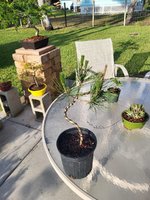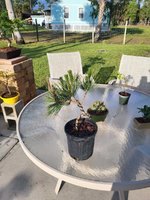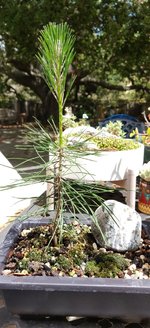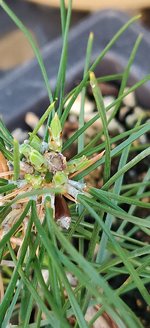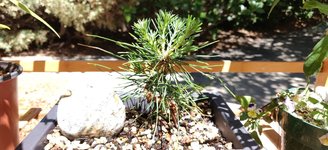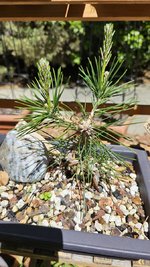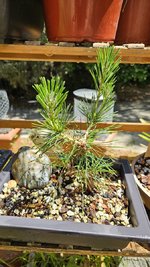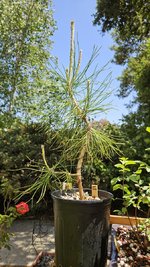Regarding "
I want to keep this one small", like
@Shibui said, there are many ways to proceed, and sometimes you are working different parts of the tree with different maturity approaches in order to force a game in some parts of the tree where that game can't be retroactively forced later (such as branch ramification). If you've wired down your branches so they descend, then the next question is something like: "
I know I will want this branch to come an inch out of the trunk and bifurcate, shouldn't I do something about that now?".
I think seeing career professionals grow black pine at the smallest scales (mame or shohin) can be illuminating because they've got it down to what they
had to do to get a branch <there> or <right there> in a reliable by-the-numbers way. They are obligated to cut somewhere or they'll have lost their last chance to reliably bifurcate in particular spot (as opposed to extending in just-let-it-grow fashion and then hoping for buds in former needle sites much later).
I have very large and bushy JBPs where even after 20 years of field growing and then 5 years in my care, I'm still growing them as if they're single flush pines, wiring down shoots, pulling down previously-wired primaries even farther with guy wire, thinning unwanted needles (various criteria), maybe doing a bit of pruning and calling it a day. There's so much bushyness and ample budding that it's easy to generate structure both at the tips and while bisecting existing branch segments somewhere in the interior. I can decide when to slip into more costly ramification techniques (decandling, cutting-past-the-candle) when I judge it's time, depending on situations local to subtrees within the greater tree.
Meanwhile as an example, I have a very twisty mame/shohin sized JBP where at the start of year 3 as a seedling, I used the costliest ramification technique. I kept going past the candle and into last year's growth, cutting to an elder needle. I wanted that shoot on that elbow of the trunk to begin ramifying at a specific spot, and it did. I'll be wiring and decandling that growth onwards. This move was recommended by Daisaku Nomoto at the Shohin School event in Portland.
From a just-let-it-grow point of view, the question arises: Shouldn't I have just let it grow because I want trunk thickening, nebari, repotting momentum, wound-closing, etc? Yes, but I haven't did away everything in the entire tree (again, different maturity approaches for different regions or subtrees).
For momentum, I have left tall/large sacrificial leader in the "poodle"-style (bushy at tip, needle-less elsewhere along its length). It's kept reduced down to one or two strong/XXL bottlebrush shoots, with very long needles. The tip isn't pruned and is let run season after season for a while until the sacrificial leader is disassembled (either by chop or back to some smaller lower support shoot). Meanwhile, the branches below are in a cycle of pad ramification (decandle, thin, wire, wait for fall, shoot select to a binary tree, clean/thin/wire again, repeat if appropriate next year).
As implied by the other comment, there are many ways to proceed and maybe the following year I instead decide I need to treat the branching as if I'm in single flush mode again, then switch back. Or skip a year of decandling if the tree weakens significantly, especially after a repot.
One more thought on the comment "
I want to keep this one small", I recommend learning how to wire pines as expertly as you can from someone in person (at a club or whatever way you can get that skill), and get as much practice as you can wiring. Also learn how to thin JBP during the branch thin-wire-laydown cycle. Once you've learned to wire pine branches, you do it at the earliest sensible opportunity on all pines you have (selectively -- don't necessarily have to wire your sacrificial leader).
Once you are wiring your JBPs, from then on, a lot of "what should I do next" of JBP is driven by the fact that you've wired things into place and you have the "input state" for next year's actions teed up. When you want to keep trees small the cycle is pretty hands-on and the biggest hands-on skill bottleneck IMO is wiring confidence.

